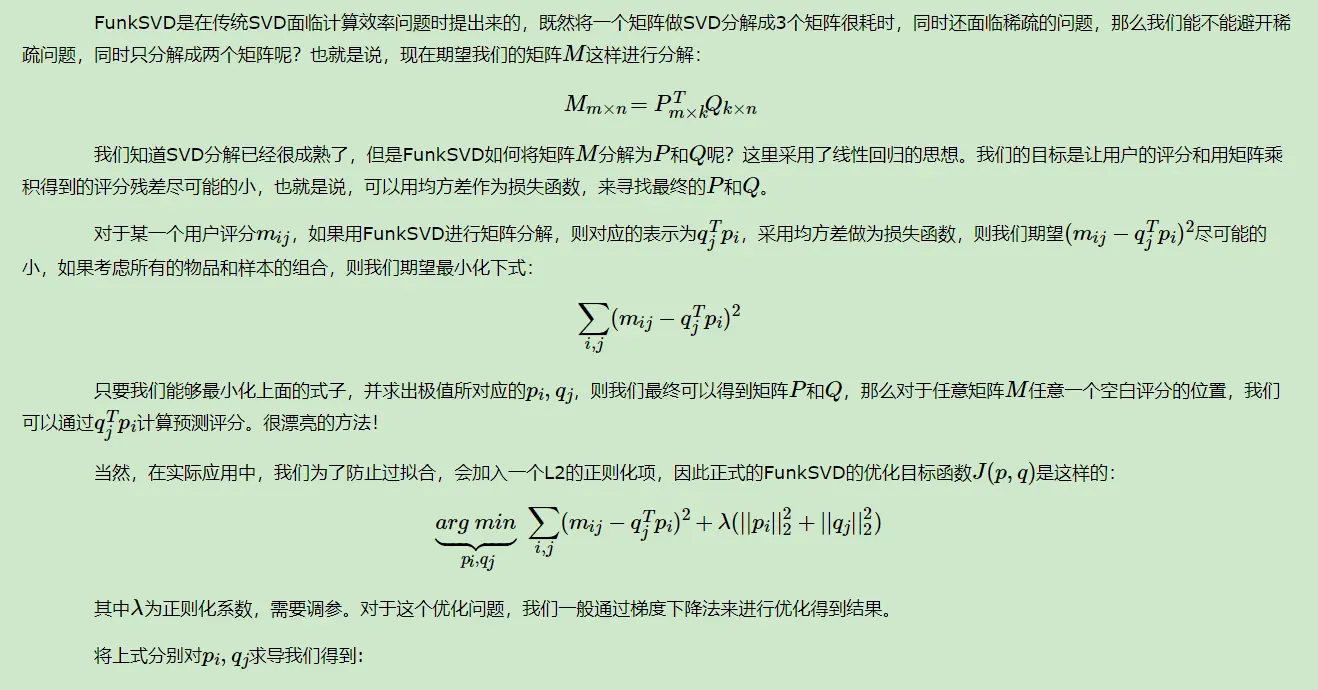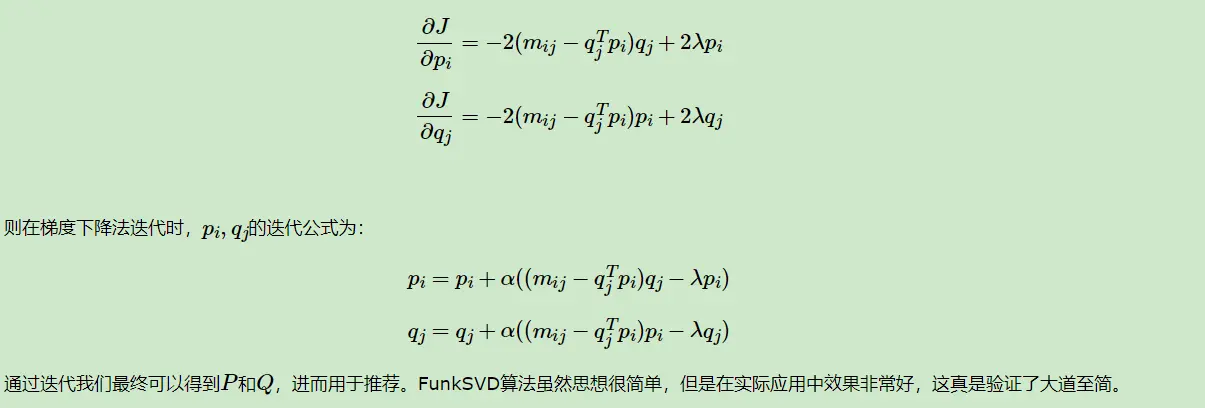花了点时间重写基于内存的矩阵(matrix)分解(decompose)拟合原始矩阵(matrix)的推荐算法,下一篇将会给出biasSVD算法,整个算法的难点在于梯度(gradient)的计算以及梯度(gradient)的更新,对于批量(batch)梯度(gradient)下降(Gradient Descent)算法可以参照相应的数学公式实现


from numpy import *
import ray
import socket
import pandas as pd
import os
from sklearn.utils import shuffle
from sklearn import preprocessing
from collections import Counter
import time
import progressbar
import matplotlib.pyplot as plt
np.seterr(divide='ignore', invalid='ignore')
'''
this is a function to come true svd model named svd++ algorithm. and using ray freamwork.
name: kenny adelaide
email: kenny13141314@163.com
time: 2021/11/17
'''
# ray.init(address='192.168.0.219:6379', _redis_password="5241590000000000")
'''
=================================================common function area==============================================================
'''
def onloaddata():
'''
onload data to memory.
Returns:matirx, userno and videono
'''
dictionary = os.path.dirname(os.path.abspath(__file__))
path = os.path.join(dictionary, 'data/00000005.csv')
o_data = pd.read_csv(path)
userno = o_data['userid'].max() + 1
videono = o_data['videoid'].max() + 1
return [o_data, userno, videono]
def build_score_matrix_R(data, userno, videono):
'''
this is common function for all algorithm-model.
via original data to build the true score matrix.
Args:
data:
userno: the max number of user code.
videono:the max number of item code.
Returns: score matrix
'''
matrix = [[None] * videono] * userno
matrix = np.array(matrix)
# matrix = np.zeros((videono, userno))
for index, row in data.iterrows():
matrix[int(row['userid']), int(row['videoid'])] = float(row['score'])
return matrix
def L2Norm(a, vector):
result = list(np.dot(vector, vector) * a)[0][0]
return result
'''
=================================================funck svd==============================================================
'''
def init_P_Q_matrix(user_disms=[3, 3], item_disms=[3, 3], init_method='quadrature'):
'''
this is a function to create two matrix for sgd training.
we via quadrature distribution function.
Args:
user_disms: user matrix shape.
item_disms: item matrix shape
init_method: generating matrix approach.
Returns:
'''
if str(init_method) == str('quadrature'):
P = random.randn(user_disms[0], user_disms[1])
Q = random.randn(item_disms[1], item_disms[0])
return [P, Q]
return
def calculate_error(P_matrix, Q_matrix, y_matrix):
'''
calculating error rator from two matrix.
Returns:
'''
rows, cols = np.nonzero(y_matrix != None)
errors = y_matrix[rows, cols] - np.sum(P_matrix[rows] * Q_matrix.T[cols], axis=1)
return errors
def gradient(P_matrix, Q_matrix, rows, cols, a, index, error):
or_row, or_col = rows[index], cols[index]
P_gradient = -2 * error * Q_matrix[:, or_col] + 2 * a * P_matrix[or_row, :]
Q_gradient = -2 * error * P_matrix[or_row, :] + 2 * a * Q_matrix[:, or_col]
return [Q_gradient, P_gradient]
def updateParameters(Q_gradient, P_gradient, P, Q, learning_rate, index, rows, cols):
or_row, or_col = rows[index], cols[index]
P[or_row, :] -= learning_rate * P_gradient
Q[:, or_col] -= learning_rate * Q_gradient
return [P, Q]
def funck_svd():
'''
train function is ford training svd++ algorithm.
defined two matrix to fit the orginal rating-matrix.
Returns: cost and iters count.
'''
[data, userno, videono] = onloaddata()
learning_rate = 0.001
iters = 50000
a = 0.005
[P, Q] = init_P_Q_matrix(user_disms=[userno, 2], item_disms=[videono, 2], init_method='quadrature')
y_matirx = build_score_matrix_R(data, userno, videono)
if not isinstance(P, np.ndarray):
P = np.array(P).around(decimals=4)
if not isinstance(Q, np.ndarray):
Q = np.array(Q).around(decimals=4)
if not isinstance(y_matirx, np.ndarray):
y_matirx = np.array(y_matirx).around(decimals=4)
rows, cols = np.nonzero(y_matirx != None)
cost_arr = []
count = 0
bar = progressbar
for i in bar.progressbar(range(iters)):
errors_matrix = calculate_error(P, Q, y_matirx)
cost = np.sum(np.square(errors_matrix))
if cost <= 0.00001:
break
for index in range(len(rows)):
[Q_gradient, P_gradient] = gradient(P, Q, rows, cols, a, index, errors_matrix[index])
[P, Q] = updateParameters(Q_gradient, P_gradient, P, Q, learning_rate, index, rows, cols)
cost_arr.append(cost)
count += 1
return cost_arr, count
版权声明:本文为博主kennyadelaide原创文章,遵循 CC 4.0 BY-SA 版权协议,转载请附上原文出处链接和本声明。
原文链接:https://blog.csdn.net/qq_17674161/article/details/121426608
